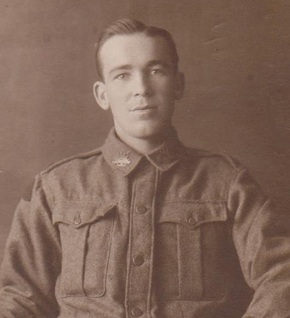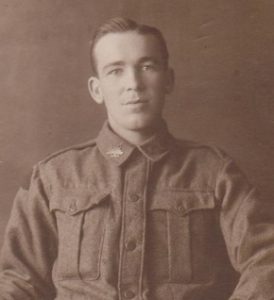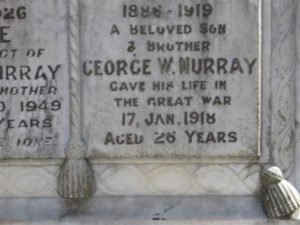When 22 year old George Wren Murray enlisted in the First World War he followed in the family’s long tradition of military service. His great grandfather, Sage Murray, had fought in the Battle of Waterloo, and his great uncles in the Sudan and Boer Wars. Orange historian William (Bill) Folster estimates that more than fifty men from the extended Murray family in the Central West answered the call to arms during the First World War.
George and his brother Sage Clyne Sinclair Murray were among the first men from the district to volunteer their services, enlisting just three weeks into the war. George served for three and a half years until he was evacuated to Tidworth Military Hospital in England with pleurisy. His condition rapidly deteriorated and he passed away on 17 January 1918, aged 25.
George was born in Orange in 1892, the fifth of thirteen children born to William Murray and his wife Alice (nee Wren) of Cargo Road. Prior to WWI George served in the Militia and the 9th Light Horse. He joined the 1st Light Horse Regiment, C Squadron, as a private, embarking HMAT A16 Star of Victoria in Sydney on 20 October 1914.
During 1915 Private Murray served on the Gallipoli peninsula. In August that year he was admitted to the 24th Casualty Clearing Station at Mudros suffering from dysentery. George kept a diary during his time at Gallipoli, recording humorous anecdotes and complaining about rations.
In March 1916 George was taken on strength with the 1st Light Horse Reserve Regiment at Heliopolis. In April 1916 he was transferred to the 4th Divisional Artillery and, in June joined the British Expeditionary Force and proceeded to France.
In late 1916 George was struck with appendicitis and evacuated to hospital in England. He endured a lengthy convalescence; he did not rejoin his unit until late November 1917. Just two weeks later he was again hospitalised, on this occasion with pleurisy. He was evacuated to England on 14 January 1918 and admitted to Tidworth Military Hospital, where he died from a combination of pleurisy and heart failure. In his obituary the Leader claimed that “no better soldier ever left these shores”.
George Wren Murray is commemorated on Nashdale Public School Honour Roll, St John’s Presbyterian Church Orange Honour Roll, the World War I Roll of Honour on the southern face of the Orange Cenotaph and on panel number 16 on the Roll of Honour at the Australian War Memorial in Canberra.
In 1923 the Anzac Memorial Avenue of trees was planted along Bathurst Road to commemorate fallen WWI soldiers. A tree was planted in honour of “Pte GW Murray”; it was donated by RG McGregor. Very few of the trees are still standing today.
George is also remembered on a commemorative plaque on his parent’s grave at Orange Cemetery, Presbyterian Block 2, Grave 59.
Sage Clyne Sinclair Murray survived the war, returning to Australia in August 1918. Another of George’s brothers, Walter Stewart Murray, also served in WWI; he returned to Australia in July 1919. A cousin, George Murray from Manildra, and second cousin, Hugh Miller Murray, also served.



